Quick filters:
Meyerbeer le prophete Stock Photos and Images
 Meyerbeer - Prophete Stock Photohttps://www.alamy.com/image-license-details/?v=1https://www.alamy.com/stock-photo-meyerbeer-prophete-105353341.html
Meyerbeer - Prophete Stock Photohttps://www.alamy.com/image-license-details/?v=1https://www.alamy.com/stock-photo-meyerbeer-prophete-105353341.htmlRMG3B779–Meyerbeer - Prophete
 Giacomo MEYERBEER - LE PROPHÈTE silk programme for the Royal Italian Opera, 25 June 1850. With VIARDOT, MARIO, TAGLIONI (ballet dancer) German composer, 5 September 1791 - 2 May 1864. Stock Photohttps://www.alamy.com/image-license-details/?v=1https://www.alamy.com/stock-photo-giacomo-meyerbeer-le-prophte-silk-programme-for-the-royal-italian-149146996.html
Giacomo MEYERBEER - LE PROPHÈTE silk programme for the Royal Italian Opera, 25 June 1850. With VIARDOT, MARIO, TAGLIONI (ballet dancer) German composer, 5 September 1791 - 2 May 1864. Stock Photohttps://www.alamy.com/image-license-details/?v=1https://www.alamy.com/stock-photo-giacomo-meyerbeer-le-prophte-silk-programme-for-the-royal-italian-149146996.htmlRMJJJ6EC–Giacomo MEYERBEER - LE PROPHÈTE silk programme for the Royal Italian Opera, 25 June 1850. With VIARDOT, MARIO, TAGLIONI (ballet dancer) German composer, 5 September 1791 - 2 May 1864.
 Meyerbeer - Prophete Stock Photohttps://www.alamy.com/image-license-details/?v=1https://www.alamy.com/stock-photo-meyerbeer-prophete-56734232.html
Meyerbeer - Prophete Stock Photohttps://www.alamy.com/image-license-details/?v=1https://www.alamy.com/stock-photo-meyerbeer-prophete-56734232.htmlRMD88D2G–Meyerbeer - Prophete
 Pauline Viardot 1821-1910. in Le Prophete by Meyerbeer Stock Photohttps://www.alamy.com/image-license-details/?v=1https://www.alamy.com/pauline-viardot-1821-1910-in-le-prophete-by-meyerbeer-image268834723.html
Pauline Viardot 1821-1910. in Le Prophete by Meyerbeer Stock Photohttps://www.alamy.com/image-license-details/?v=1https://www.alamy.com/pauline-viardot-1821-1910-in-le-prophete-by-meyerbeer-image268834723.htmlRMWHADC3–Pauline Viardot 1821-1910. in Le Prophete by Meyerbeer
 Meyerbeer - Prophete Stock Photohttps://www.alamy.com/image-license-details/?v=1https://www.alamy.com/stock-photo-meyerbeer-prophete-105353337.html
Meyerbeer - Prophete Stock Photohttps://www.alamy.com/image-license-details/?v=1https://www.alamy.com/stock-photo-meyerbeer-prophete-105353337.htmlRMG3B775–Meyerbeer - Prophete
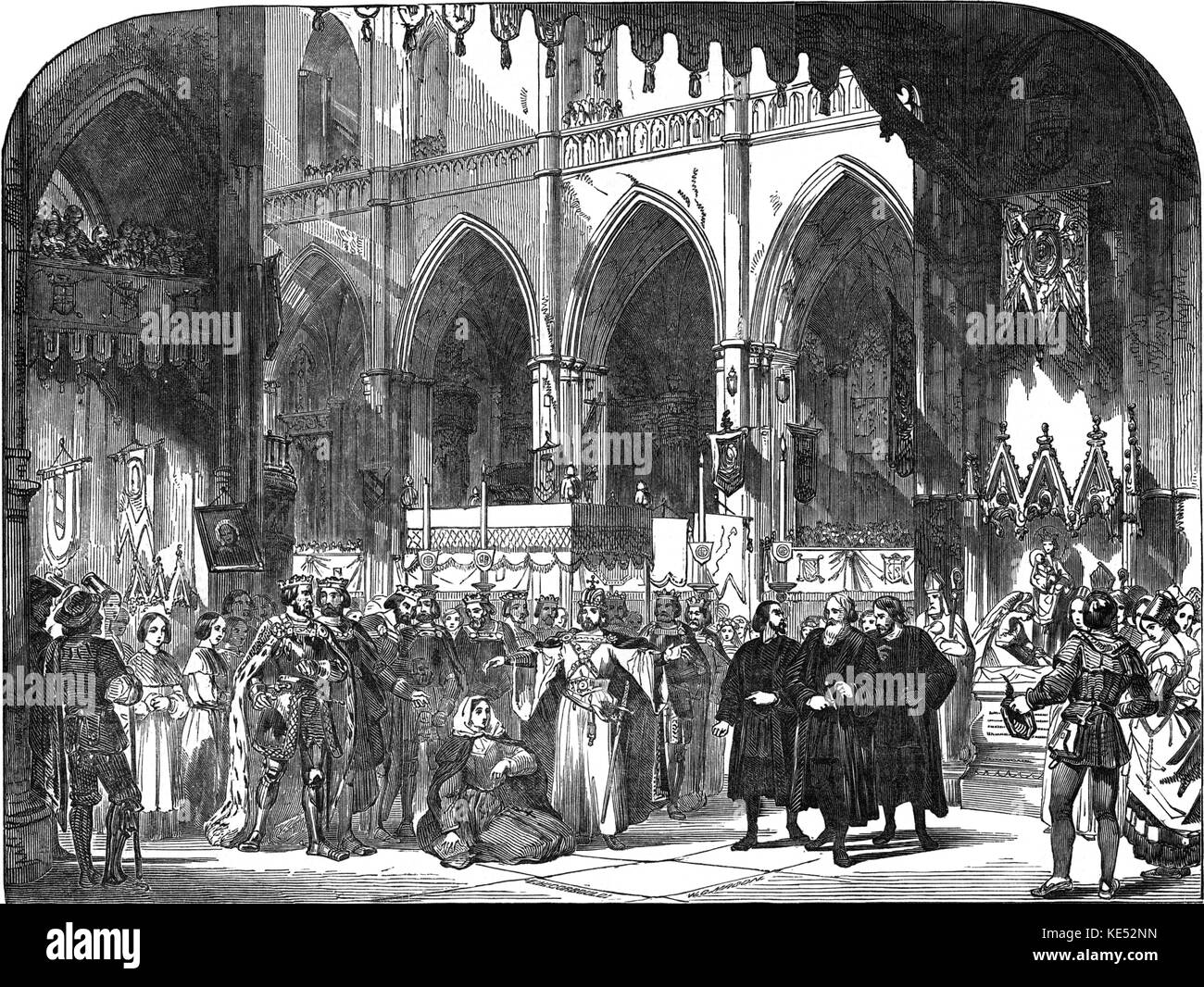 Le prophete by Meyerbeer at Royal Italian Opera, Covent Garden, London 1849 (London premiere). The Coronation scene. Performers: Viardot, Hayes, Mario, Tagliafico, conductor Costa. Source: Illustrated London News28 July, 1849. German composer, 5 September 1791 - 2 May 1864. Stock Photohttps://www.alamy.com/image-license-details/?v=1https://www.alamy.com/stock-image-le-prophete-by-meyerbeer-at-royal-italian-opera-covent-garden-london-163610433.html
Le prophete by Meyerbeer at Royal Italian Opera, Covent Garden, London 1849 (London premiere). The Coronation scene. Performers: Viardot, Hayes, Mario, Tagliafico, conductor Costa. Source: Illustrated London News28 July, 1849. German composer, 5 September 1791 - 2 May 1864. Stock Photohttps://www.alamy.com/image-license-details/?v=1https://www.alamy.com/stock-image-le-prophete-by-meyerbeer-at-royal-italian-opera-covent-garden-london-163610433.htmlRMKE52NN–Le prophete by Meyerbeer at Royal Italian Opera, Covent Garden, London 1849 (London premiere). The Coronation scene. Performers: Viardot, Hayes, Mario, Tagliafico, conductor Costa. Source: Illustrated London News28 July, 1849. German composer, 5 September 1791 - 2 May 1864.
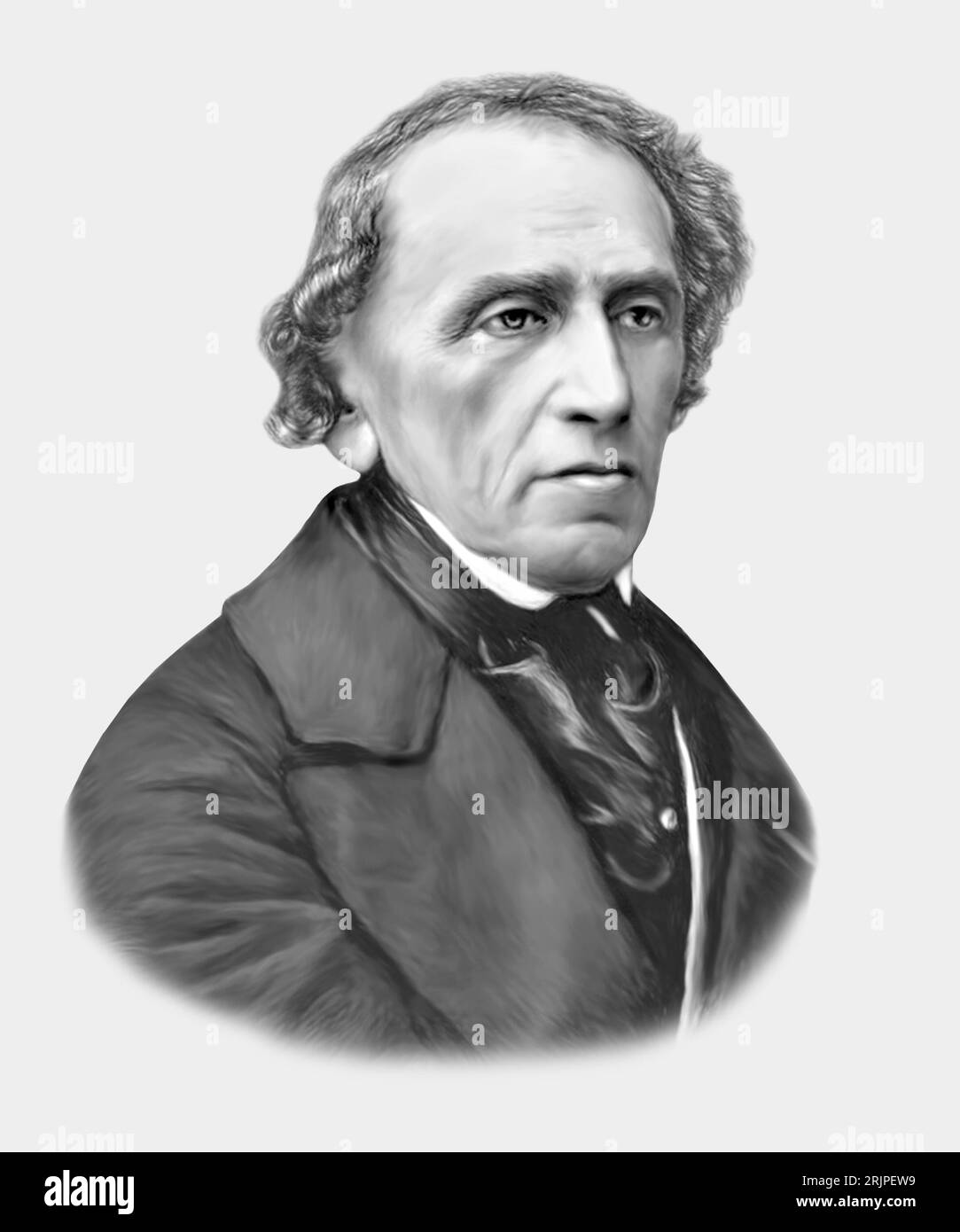 Giacomo Meyerbeer 1791-1864 German Composer Stock Photohttps://www.alamy.com/image-license-details/?v=1https://www.alamy.com/giacomo-meyerbeer-1791-1864-german-composer-image562290213.html
Giacomo Meyerbeer 1791-1864 German Composer Stock Photohttps://www.alamy.com/image-license-details/?v=1https://www.alamy.com/giacomo-meyerbeer-1791-1864-german-composer-image562290213.htmlRM2RJPEW9–Giacomo Meyerbeer 1791-1864 German Composer
 Electric stage light used in Giacomo Meyerbeer's The Prophet (Le Prophète) to imitate the sun - from engraving published 1885. Stock Photohttps://www.alamy.com/image-license-details/?v=1https://www.alamy.com/stock-photo-electric-stage-light-used-in-giacomo-meyerbeers-the-prophet-le-prophte-83345393.html
Electric stage light used in Giacomo Meyerbeer's The Prophet (Le Prophète) to imitate the sun - from engraving published 1885. Stock Photohttps://www.alamy.com/image-license-details/?v=1https://www.alamy.com/stock-photo-electric-stage-light-used-in-giacomo-meyerbeers-the-prophet-le-prophte-83345393.htmlRMERGKW5–Electric stage light used in Giacomo Meyerbeer's The Prophet (Le Prophète) to imitate the sun - from engraving published 1885.
 Giacomo Meyerbeer 1791-1864 German Composer Stock Photohttps://www.alamy.com/image-license-details/?v=1https://www.alamy.com/giacomo-meyerbeer-1791-1864-german-composer-image562290019.html
Giacomo Meyerbeer 1791-1864 German Composer Stock Photohttps://www.alamy.com/image-license-details/?v=1https://www.alamy.com/giacomo-meyerbeer-1791-1864-german-composer-image562290019.htmlRM2RJPEJB–Giacomo Meyerbeer 1791-1864 German Composer
 Portrait of Giacomo Meyerbeer (1791-1864) a German opera composer. Dated 19th Century Stock Photohttps://www.alamy.com/image-license-details/?v=1https://www.alamy.com/stock-photo-portrait-of-giacomo-meyerbeer-1791-1864-a-german-opera-composer-dated-122881444.html
Portrait of Giacomo Meyerbeer (1791-1864) a German opera composer. Dated 19th Century Stock Photohttps://www.alamy.com/image-license-details/?v=1https://www.alamy.com/stock-photo-portrait-of-giacomo-meyerbeer-1791-1864-a-german-opera-composer-dated-122881444.htmlRMH3WMF0–Portrait of Giacomo Meyerbeer (1791-1864) a German opera composer. Dated 19th Century
 DELNA, Marie - in 'Le Prophete' by Meyerbeer From 'Le Petit Journal' 29th May, 1898. French contralto (1875-1932). Stock Photohttps://www.alamy.com/image-license-details/?v=1https://www.alamy.com/delna-marie-in-le-prophete-by-meyerbeer-from-le-petit-journal-29th-image155404667.html
DELNA, Marie - in 'Le Prophete' by Meyerbeer From 'Le Petit Journal' 29th May, 1898. French contralto (1875-1932). Stock Photohttps://www.alamy.com/image-license-details/?v=1https://www.alamy.com/delna-marie-in-le-prophete-by-meyerbeer-from-le-petit-journal-29th-image155404667.htmlRMK0R86K–DELNA, Marie - in 'Le Prophete' by Meyerbeer From 'Le Petit Journal' 29th May, 1898. French contralto (1875-1932).
 . Français : Portrait de Meyerbeer par Karl Begas peint entre le 22 février et juin 1851, et commandé par le roi de Prusse Frédéric Guillaume IV. Le compositeur porte les insignes de l'Ordre pour le Mérite, ainsi que le manuscrit de la marche du couronnement du Prophète. L'original a disparu pendant la seconde guerre mondiale. English: Portrait of Meyerbeer by Karl Begas, commissioned by King Friedrich Wilhelm IV of Prussia. The composer is wearing the insignia of the Ordre pour le Mérite and holding the manuscript of the Coronation March from Le Prophète (painted 22 Feb.-June 1851). The origi Stock Photohttps://www.alamy.com/image-license-details/?v=1https://www.alamy.com/franais-portrait-de-meyerbeer-par-karl-begas-peint-entre-le-22-fvrier-et-juin-1851-et-command-par-le-roi-de-prusse-frdric-guillaume-iv-le-compositeur-porte-les-insignes-de-lordre-pour-le-mrite-ainsi-que-le-manuscrit-de-la-marche-du-couronnement-du-prophte-loriginal-a-disparu-pendant-la-seconde-guerre-mondiale-english-portrait-of-meyerbeer-by-karl-begas-commissioned-by-king-friedrich-wilhelm-iv-of-prussia-the-composer-is-wearing-the-insignia-of-the-ordre-pour-le-mrite-and-holding-the-manuscript-of-the-coronation-march-from-le-prophte-painted-22-feb-june-1851-the-origi-image189297195.html
. Français : Portrait de Meyerbeer par Karl Begas peint entre le 22 février et juin 1851, et commandé par le roi de Prusse Frédéric Guillaume IV. Le compositeur porte les insignes de l'Ordre pour le Mérite, ainsi que le manuscrit de la marche du couronnement du Prophète. L'original a disparu pendant la seconde guerre mondiale. English: Portrait of Meyerbeer by Karl Begas, commissioned by King Friedrich Wilhelm IV of Prussia. The composer is wearing the insignia of the Ordre pour le Mérite and holding the manuscript of the Coronation March from Le Prophète (painted 22 Feb.-June 1851). The origi Stock Photohttps://www.alamy.com/image-license-details/?v=1https://www.alamy.com/franais-portrait-de-meyerbeer-par-karl-begas-peint-entre-le-22-fvrier-et-juin-1851-et-command-par-le-roi-de-prusse-frdric-guillaume-iv-le-compositeur-porte-les-insignes-de-lordre-pour-le-mrite-ainsi-que-le-manuscrit-de-la-marche-du-couronnement-du-prophte-loriginal-a-disparu-pendant-la-seconde-guerre-mondiale-english-portrait-of-meyerbeer-by-karl-begas-commissioned-by-king-friedrich-wilhelm-iv-of-prussia-the-composer-is-wearing-the-insignia-of-the-ordre-pour-le-mrite-and-holding-the-manuscript-of-the-coronation-march-from-le-prophte-painted-22-feb-june-1851-the-origi-image189297195.htmlRMMYY6E3–. Français : Portrait de Meyerbeer par Karl Begas peint entre le 22 février et juin 1851, et commandé par le roi de Prusse Frédéric Guillaume IV. Le compositeur porte les insignes de l'Ordre pour le Mérite, ainsi que le manuscrit de la marche du couronnement du Prophète. L'original a disparu pendant la seconde guerre mondiale. English: Portrait of Meyerbeer by Karl Begas, commissioned by King Friedrich Wilhelm IV of Prussia. The composer is wearing the insignia of the Ordre pour le Mérite and holding the manuscript of the Coronation March from Le Prophète (painted 22 Feb.-June 1851). The origi
 'Le prophete' Opera de Giacomo Meyerbeer (Jakob Liebmann Beer, 1791-1864), compositeur allemand : le prophete perit dans l'incendie du palais de Munst Stock Photohttps://www.alamy.com/image-license-details/?v=1https://www.alamy.com/le-prophete-opera-de-giacomo-meyerbeer-jakob-liebmann-beer-1791-1864-compositeur-allemand-le-prophete-perit-dans-lincendie-du-palais-de-munst-image356889430.html
'Le prophete' Opera de Giacomo Meyerbeer (Jakob Liebmann Beer, 1791-1864), compositeur allemand : le prophete perit dans l'incendie du palais de Munst Stock Photohttps://www.alamy.com/image-license-details/?v=1https://www.alamy.com/le-prophete-opera-de-giacomo-meyerbeer-jakob-liebmann-beer-1791-1864-compositeur-allemand-le-prophete-perit-dans-lincendie-du-palais-de-munst-image356889430.htmlRM2BMHM32–'Le prophete' Opera de Giacomo Meyerbeer (Jakob Liebmann Beer, 1791-1864), compositeur allemand : le prophete perit dans l'incendie du palais de Munst
 Nouveau traité d'instrumentation . Meyerbeer, LE PROPHETE. Acte IV,Complainte de la mendiante ( p. 508 de la gr. part.) En Allemagne Richard Wagner a introduit lusage, depuis Lohengrin (1847), décrire troisparties de basson. > Ex.234. 2 Cors à pistonsen Mi <2eet ie). SIEGLIKDE Ein Fremdpr trat du hcr - tin, cin Greis in grauem Ge.wand; Trois Cors tief hing ihm dei Cor? Stock Photohttps://www.alamy.com/image-license-details/?v=1https://www.alamy.com/nouveau-trait-dinstrumentation-meyerbeer-le-prophete-acte-ivcomplainte-de-la-mendiante-p-508-de-la-gr-part-en-allemagne-richard-wagner-a-introduit-lusage-depuis-lohengrin-1847-dcrire-troisparties-de-basson-gt-ex234-2-cors-pistonsen-mi-lt2eet-ie-sieglikde-ein-fremdpr-trat-du-hcr-tin-cin-greis-in-grauem-gewand-trois-cors-tief-hing-ihm-dei-cor-image342730299.html
Nouveau traité d'instrumentation . Meyerbeer, LE PROPHETE. Acte IV,Complainte de la mendiante ( p. 508 de la gr. part.) En Allemagne Richard Wagner a introduit lusage, depuis Lohengrin (1847), décrire troisparties de basson. > Ex.234. 2 Cors à pistonsen Mi <2eet ie). SIEGLIKDE Ein Fremdpr trat du hcr - tin, cin Greis in grauem Ge.wand; Trois Cors tief hing ihm dei Cor? Stock Photohttps://www.alamy.com/image-license-details/?v=1https://www.alamy.com/nouveau-trait-dinstrumentation-meyerbeer-le-prophete-acte-ivcomplainte-de-la-mendiante-p-508-de-la-gr-part-en-allemagne-richard-wagner-a-introduit-lusage-depuis-lohengrin-1847-dcrire-troisparties-de-basson-gt-ex234-2-cors-pistonsen-mi-lt2eet-ie-sieglikde-ein-fremdpr-trat-du-hcr-tin-cin-greis-in-grauem-gewand-trois-cors-tief-hing-ihm-dei-cor-image342730299.htmlRM2AWGKYR–Nouveau traité d'instrumentation . Meyerbeer, LE PROPHETE. Acte IV,Complainte de la mendiante ( p. 508 de la gr. part.) En Allemagne Richard Wagner a introduit lusage, depuis Lohengrin (1847), décrire troisparties de basson. > Ex.234. 2 Cors à pistonsen Mi <2eet ie). SIEGLIKDE Ein Fremdpr trat du hcr - tin, cin Greis in grauem Ge.wand; Trois Cors tief hing ihm dei Cor?
 Flute ca. 1852 Jean-Louis Tulou French The cross-fingerings used on simple-system flutes such as this created subtle variations in tone color from note to note. Despite the eventual dominance of Boehm’s 1847 cylindrical flute, many players preferred simple-system instruments throughout the nineteenth century. Tulou, a flautist with the Paris Opéra and professor at the Conservatoire, expressly rejected the Boehm flute. Listen to experts illuminate this artwork's story Listen Play or pause #Romance/Waltz from Récréations musicales sur des motifs d'opéra Le Prophéte, Op. 321 by Giacomo Meyerbeer Stock Photohttps://www.alamy.com/image-license-details/?v=1https://www.alamy.com/flute-ca-1852-jean-louis-tulou-french-the-cross-fingerings-used-on-simple-system-flutes-such-as-this-created-subtle-variations-in-tone-color-from-note-to-note-despite-the-eventual-dominance-of-boehms-1847-cylindrical-flute-many-players-preferred-simple-system-instruments-throughout-the-nineteenth-century-tulou-a-flautist-with-the-paris-opra-and-professor-at-the-conservatoire-expressly-rejected-the-boehm-flute-listen-to-experts-illuminate-this-artworks-story-listen-play-or-pause-romancewaltz-from-rcrations-musicales-sur-des-motifs-dopra-le-prophte-op-321-by-giacomo-meyerbeer-image458460102.html
Flute ca. 1852 Jean-Louis Tulou French The cross-fingerings used on simple-system flutes such as this created subtle variations in tone color from note to note. Despite the eventual dominance of Boehm’s 1847 cylindrical flute, many players preferred simple-system instruments throughout the nineteenth century. Tulou, a flautist with the Paris Opéra and professor at the Conservatoire, expressly rejected the Boehm flute. Listen to experts illuminate this artwork's story Listen Play or pause #Romance/Waltz from Récréations musicales sur des motifs d'opéra Le Prophéte, Op. 321 by Giacomo Meyerbeer Stock Photohttps://www.alamy.com/image-license-details/?v=1https://www.alamy.com/flute-ca-1852-jean-louis-tulou-french-the-cross-fingerings-used-on-simple-system-flutes-such-as-this-created-subtle-variations-in-tone-color-from-note-to-note-despite-the-eventual-dominance-of-boehms-1847-cylindrical-flute-many-players-preferred-simple-system-instruments-throughout-the-nineteenth-century-tulou-a-flautist-with-the-paris-opra-and-professor-at-the-conservatoire-expressly-rejected-the-boehm-flute-listen-to-experts-illuminate-this-artworks-story-listen-play-or-pause-romancewaltz-from-rcrations-musicales-sur-des-motifs-dopra-le-prophte-op-321-by-giacomo-meyerbeer-image458460102.htmlRM2HHTJF2–Flute ca. 1852 Jean-Louis Tulou French The cross-fingerings used on simple-system flutes such as this created subtle variations in tone color from note to note. Despite the eventual dominance of Boehm’s 1847 cylindrical flute, many players preferred simple-system instruments throughout the nineteenth century. Tulou, a flautist with the Paris Opéra and professor at the Conservatoire, expressly rejected the Boehm flute. Listen to experts illuminate this artwork's story Listen Play or pause #Romance/Waltz from Récréations musicales sur des motifs d'opéra Le Prophéte, Op. 321 by Giacomo Meyerbeer
 Meyerbeer - Prophete Stock Photohttps://www.alamy.com/image-license-details/?v=1https://www.alamy.com/stock-photo-meyerbeer-prophete-105353340.html
Meyerbeer - Prophete Stock Photohttps://www.alamy.com/image-license-details/?v=1https://www.alamy.com/stock-photo-meyerbeer-prophete-105353340.htmlRMG3B778–Meyerbeer - Prophete
 Le prophète/ The Prophet, opera by Giacomo Meyerbeer. Act III, scene 1- the skating interlude. GM: German composer, 5 September 1791 - 2 May 1864. Stereoscopic card (colour), photograph of hand painted clay models, 1860s - from series Les Theatres de Paris - 12 Scenes Vues au Stereoscope. Stock Photohttps://www.alamy.com/image-license-details/?v=1https://www.alamy.com/stock-photo-le-prophte-the-prophet-opera-by-giacomo-meyerbeer-act-iii-scene-1-149147627.html
Le prophète/ The Prophet, opera by Giacomo Meyerbeer. Act III, scene 1- the skating interlude. GM: German composer, 5 September 1791 - 2 May 1864. Stereoscopic card (colour), photograph of hand painted clay models, 1860s - from series Les Theatres de Paris - 12 Scenes Vues au Stereoscope. Stock Photohttps://www.alamy.com/image-license-details/?v=1https://www.alamy.com/stock-photo-le-prophte-the-prophet-opera-by-giacomo-meyerbeer-act-iii-scene-1-149147627.htmlRMJJJ78Y–Le prophète/ The Prophet, opera by Giacomo Meyerbeer. Act III, scene 1- the skating interlude. GM: German composer, 5 September 1791 - 2 May 1864. Stereoscopic card (colour), photograph of hand painted clay models, 1860s - from series Les Theatres de Paris - 12 Scenes Vues au Stereoscope.
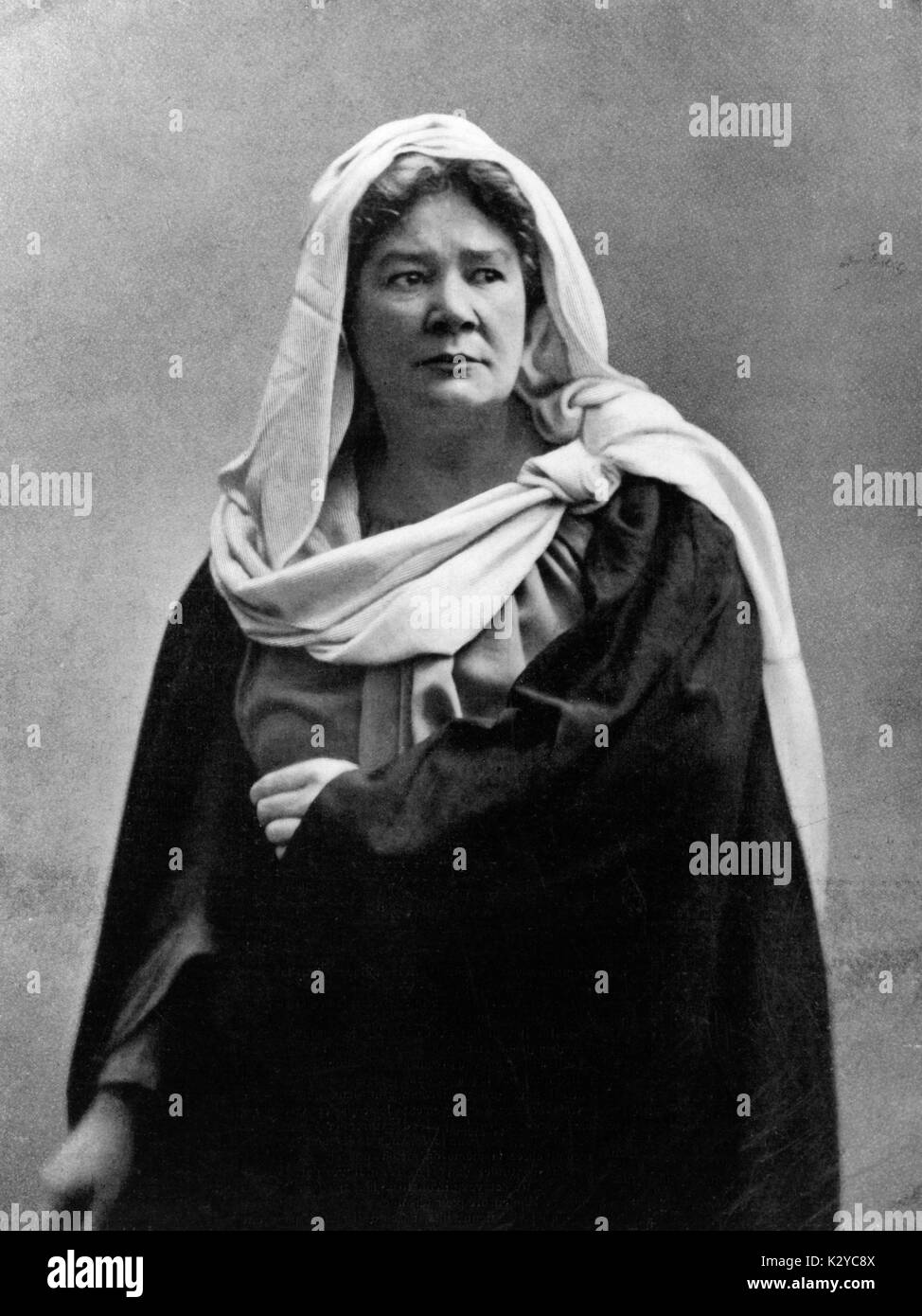 Ernestina Schumann-Heink - portrait as Fides in Meyerbeer 's 'Le Prophete' - Czech-American contralto singer - 15 June 1861-17 November 1936 Stock Photohttps://www.alamy.com/image-license-details/?v=1https://www.alamy.com/ernestina-schumann-heink-portrait-as-fides-in-meyerbeer-s-le-prophete-image156724986.html
Ernestina Schumann-Heink - portrait as Fides in Meyerbeer 's 'Le Prophete' - Czech-American contralto singer - 15 June 1861-17 November 1936 Stock Photohttps://www.alamy.com/image-license-details/?v=1https://www.alamy.com/ernestina-schumann-heink-portrait-as-fides-in-meyerbeer-s-le-prophete-image156724986.htmlRMK2YC8X–Ernestina Schumann-Heink - portrait as Fides in Meyerbeer 's 'Le Prophete' - Czech-American contralto singer - 15 June 1861-17 November 1936
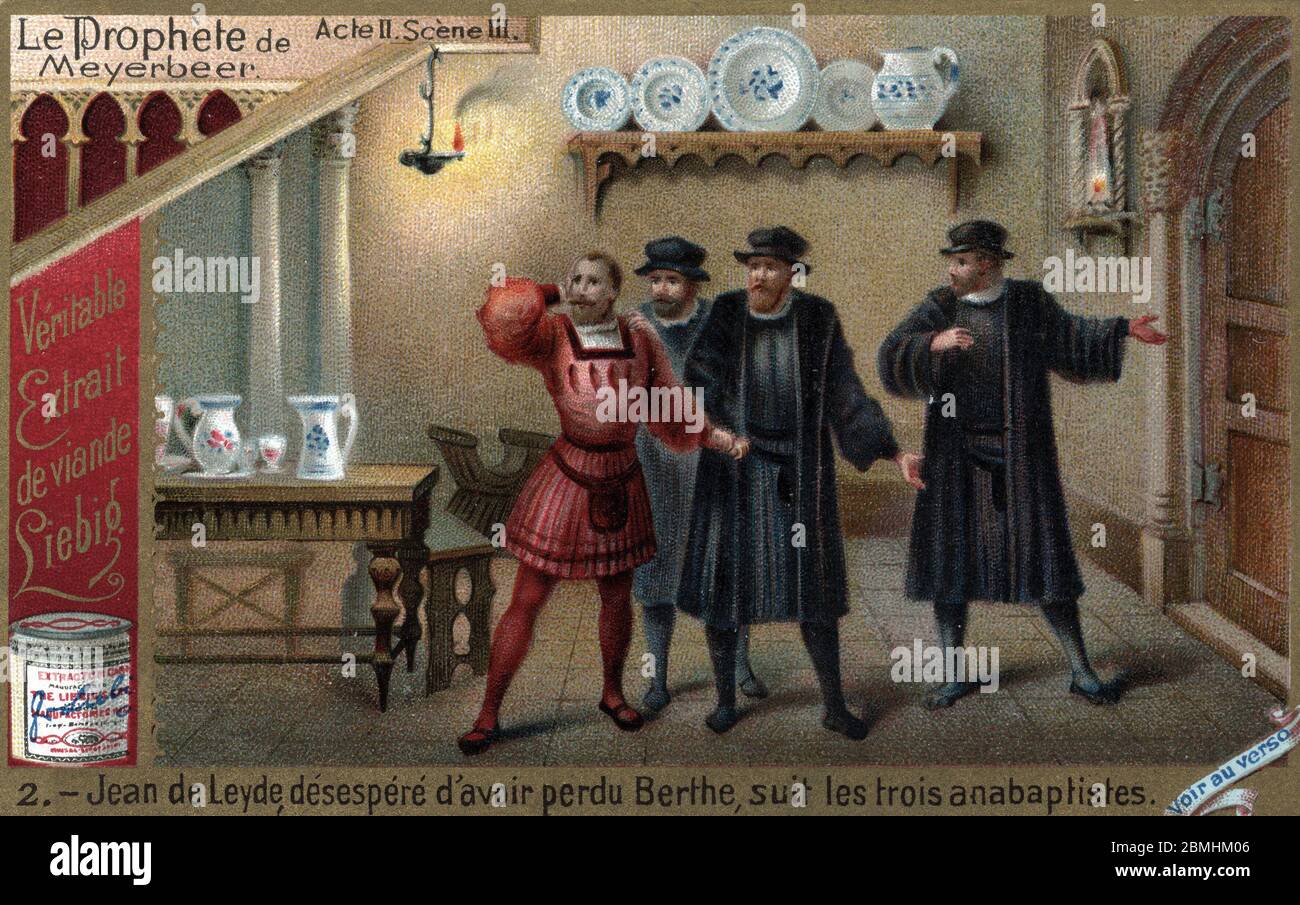 'Le prophete' Opera de Giacomo Meyerbeer (Jakob Liebmann Beer, 1791-1864), compositeur allemand : jean de Leyde, desespere d'avoir perdu Berthe suit l Stock Photohttps://www.alamy.com/image-license-details/?v=1https://www.alamy.com/le-prophete-opera-de-giacomo-meyerbeer-jakob-liebmann-beer-1791-1864-compositeur-allemand-jean-de-leyde-desespere-davoir-perdu-berthe-suit-l-image356889350.html
'Le prophete' Opera de Giacomo Meyerbeer (Jakob Liebmann Beer, 1791-1864), compositeur allemand : jean de Leyde, desespere d'avoir perdu Berthe suit l Stock Photohttps://www.alamy.com/image-license-details/?v=1https://www.alamy.com/le-prophete-opera-de-giacomo-meyerbeer-jakob-liebmann-beer-1791-1864-compositeur-allemand-jean-de-leyde-desespere-davoir-perdu-berthe-suit-l-image356889350.htmlRM2BMHM06–'Le prophete' Opera de Giacomo Meyerbeer (Jakob Liebmann Beer, 1791-1864), compositeur allemand : jean de Leyde, desespere d'avoir perdu Berthe suit l
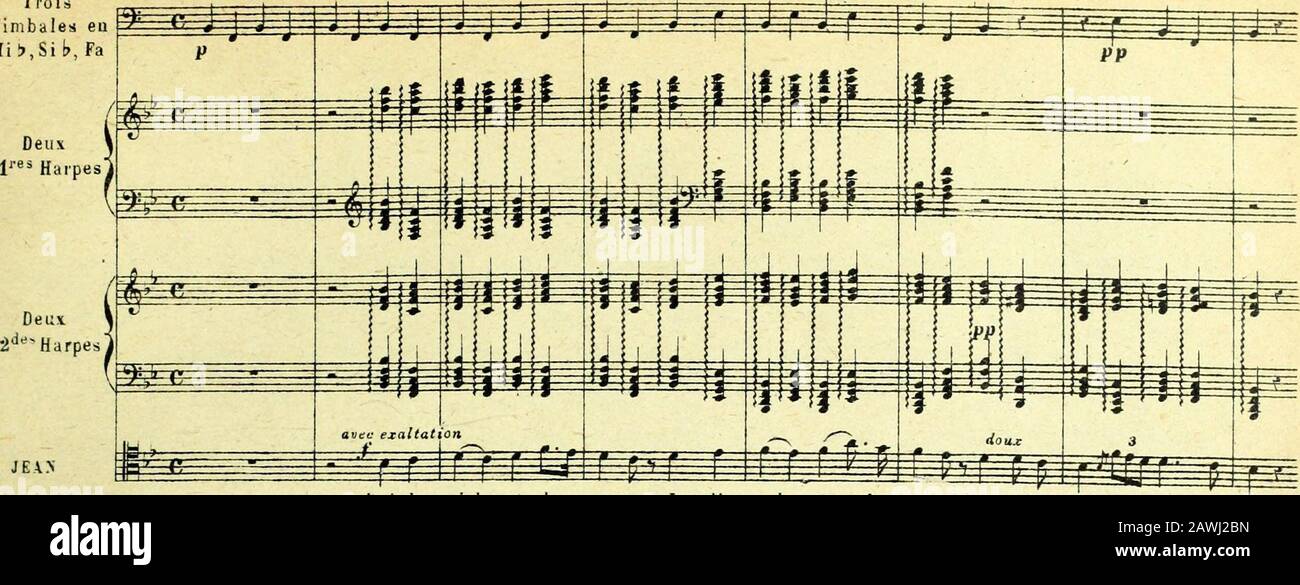 Nouveau traité d'instrumentation . -lai, (solj-si ?>). 4° si-rél Ut -mi i> ), 5° mi-sol*( fa b-la if).. 8854. a. HARPE 87 Ex. 140 TroisTimbales euMi!>,Sil>, Fa Deuxlres Harpes Ail0 maestoso,. JEAN Roi du >.i«l et des au.ges, Je di . rai tes lou.anges CommeDa.vid ton ser. vi.teur Meyerbeer, LE PROPHETE, Acte III, p.476. Ex. 141. Andtecautabile.69zJ. 1 Violons idi Violons Stock Photohttps://www.alamy.com/image-license-details/?v=1https://www.alamy.com/nouveau-trait-dinstrumentation-lai-solj-si-gt-4-si-rl-ut-mi-igt-5-mi-sol-fa-b-la-if-8854-a-harpe-87-ex-140-troistimbales-eumi!gtsilgt-fa-deuxlres-harpes-ail0-maestoso-jean-roi-du-gtil-et-des-auges-je-di-rai-tes-louanges-commedavid-ton-ser-viteur-meyerbeer-le-prophete-acte-iii-p476-ex-141-andtecautabile69zj-1-violons-idi-violons-image342760425.html
Nouveau traité d'instrumentation . -lai, (solj-si ?>). 4° si-rél Ut -mi i> ), 5° mi-sol*( fa b-la if).. 8854. a. HARPE 87 Ex. 140 TroisTimbales euMi!>,Sil>, Fa Deuxlres Harpes Ail0 maestoso,. JEAN Roi du >.i«l et des au.ges, Je di . rai tes lou.anges CommeDa.vid ton ser. vi.teur Meyerbeer, LE PROPHETE, Acte III, p.476. Ex. 141. Andtecautabile.69zJ. 1 Violons idi Violons Stock Photohttps://www.alamy.com/image-license-details/?v=1https://www.alamy.com/nouveau-trait-dinstrumentation-lai-solj-si-gt-4-si-rl-ut-mi-igt-5-mi-sol-fa-b-la-if-8854-a-harpe-87-ex-140-troistimbales-eumi!gtsilgt-fa-deuxlres-harpes-ail0-maestoso-jean-roi-du-gtil-et-des-auges-je-di-rai-tes-louanges-commedavid-ton-ser-viteur-meyerbeer-le-prophete-acte-iii-p476-ex-141-andtecautabile69zj-1-violons-idi-violons-image342760425.htmlRM2AWJ2BN–Nouveau traité d'instrumentation . -lai, (solj-si ?>). 4° si-rél Ut -mi i> ), 5° mi-sol*( fa b-la if).. 8854. a. HARPE 87 Ex. 140 TroisTimbales euMi!>,Sil>, Fa Deuxlres Harpes Ail0 maestoso,. JEAN Roi du >.i«l et des au.ges, Je di . rai tes lou.anges CommeDa.vid ton ser. vi.teur Meyerbeer, LE PROPHETE, Acte III, p.476. Ex. 141. Andtecautabile.69zJ. 1 Violons idi Violons
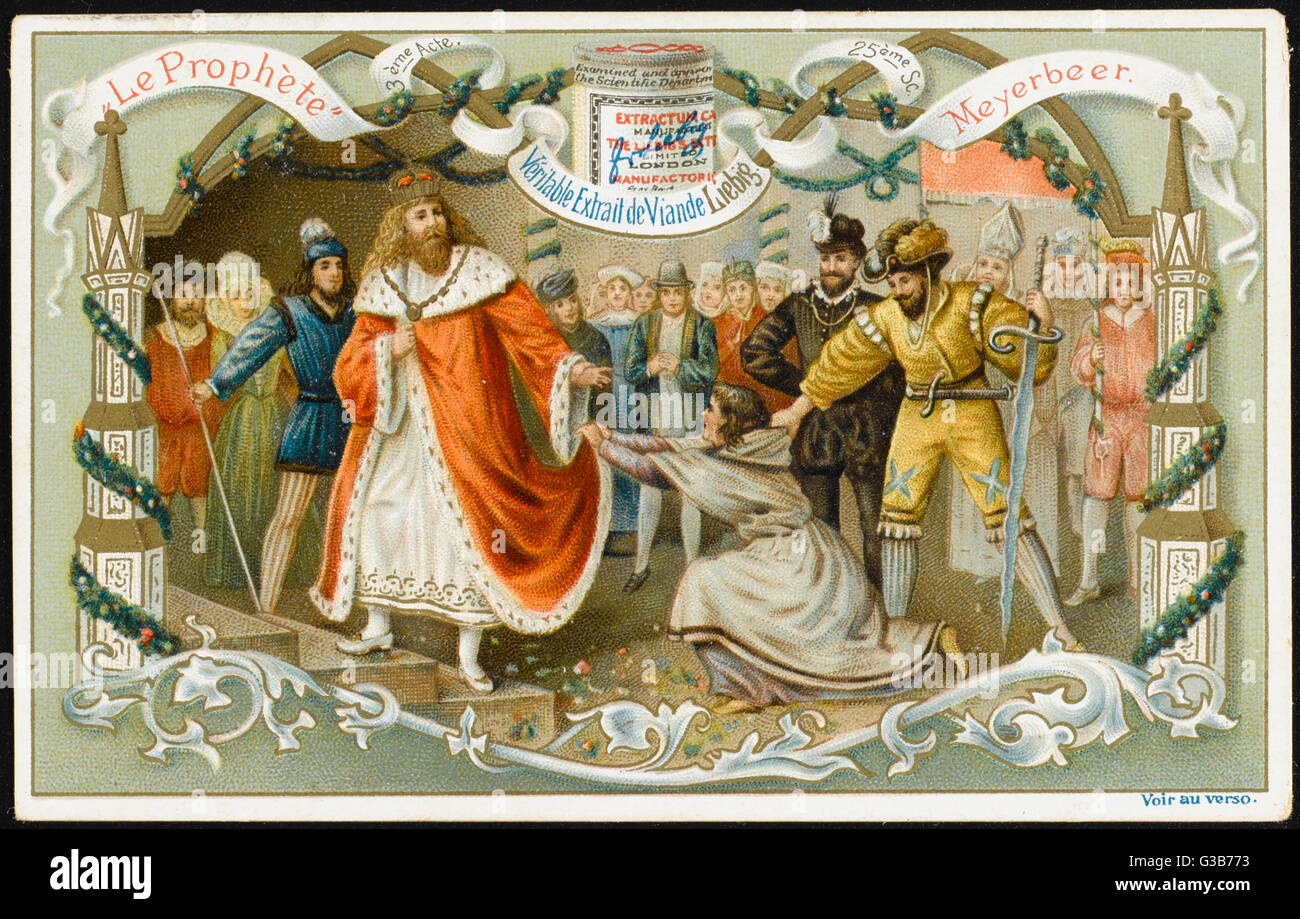 Meyerbeer - Prophete Stock Photohttps://www.alamy.com/image-license-details/?v=1https://www.alamy.com/stock-photo-meyerbeer-prophete-105353335.html
Meyerbeer - Prophete Stock Photohttps://www.alamy.com/image-license-details/?v=1https://www.alamy.com/stock-photo-meyerbeer-prophete-105353335.htmlRMG3B773–Meyerbeer - Prophete
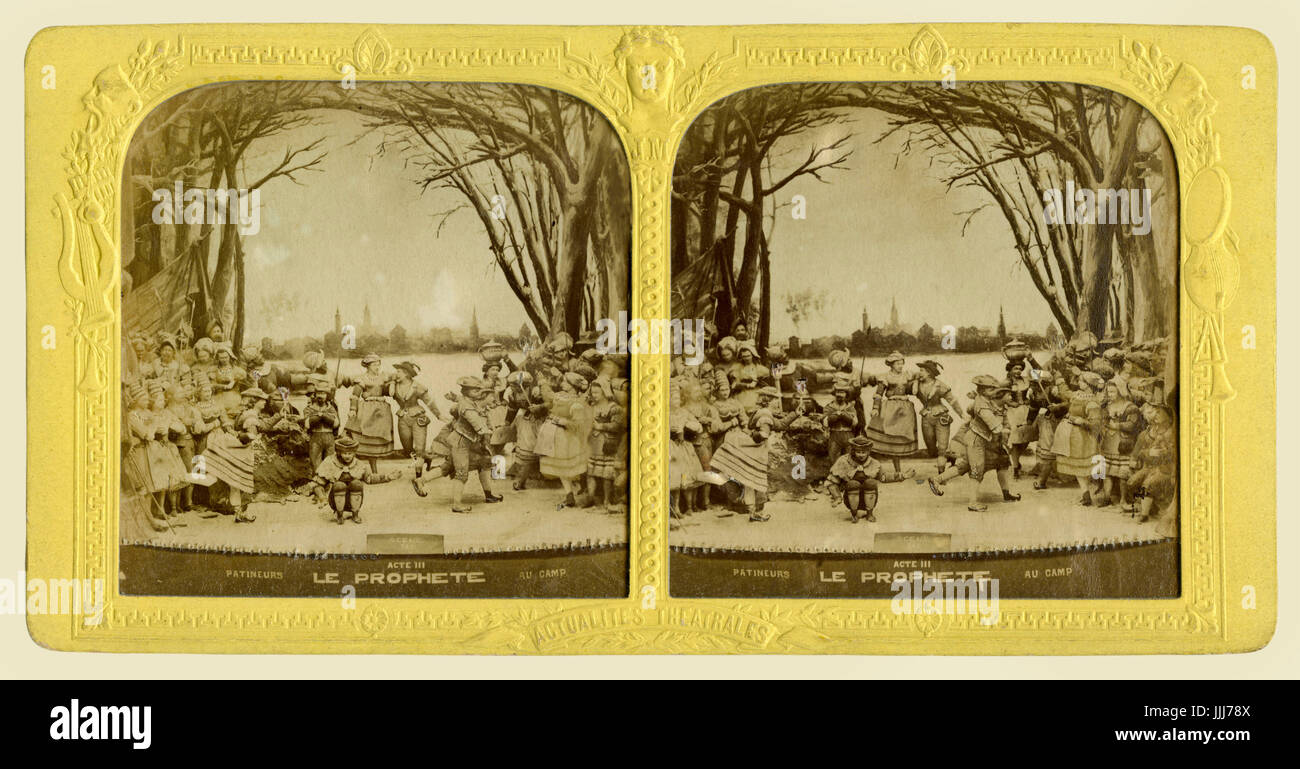 Le prophète/ The Prophet, opera by Giacomo Meyerbeer. Act III, scene 1- the skating interlude. GM: German composer, 5 September 1791 - 2 May 1864. Stereoscopic card (B+W), photograph of hand painted clay models, 1860s - from series Les Theatres de Paris - 6 Scenes Vues au Stereoscope. Stock Photohttps://www.alamy.com/image-license-details/?v=1https://www.alamy.com/stock-photo-le-prophte-the-prophet-opera-by-giacomo-meyerbeer-act-iii-scene-1-149147626.html
Le prophète/ The Prophet, opera by Giacomo Meyerbeer. Act III, scene 1- the skating interlude. GM: German composer, 5 September 1791 - 2 May 1864. Stereoscopic card (B+W), photograph of hand painted clay models, 1860s - from series Les Theatres de Paris - 6 Scenes Vues au Stereoscope. Stock Photohttps://www.alamy.com/image-license-details/?v=1https://www.alamy.com/stock-photo-le-prophte-the-prophet-opera-by-giacomo-meyerbeer-act-iii-scene-1-149147626.htmlRMJJJ78X–Le prophète/ The Prophet, opera by Giacomo Meyerbeer. Act III, scene 1- the skating interlude. GM: German composer, 5 September 1791 - 2 May 1864. Stereoscopic card (B+W), photograph of hand painted clay models, 1860s - from series Les Theatres de Paris - 6 Scenes Vues au Stereoscope.
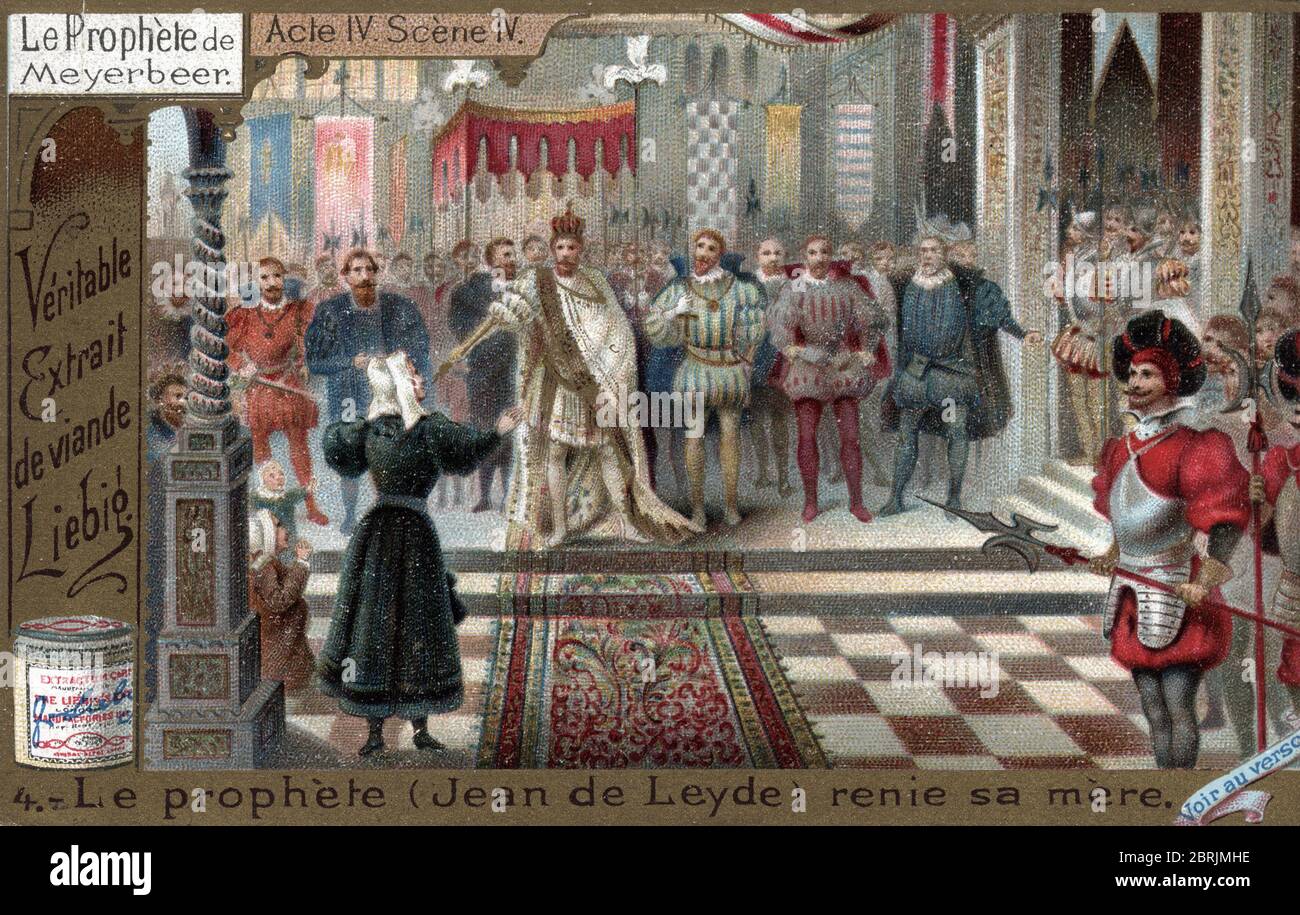 'Le prophete' Opera de Giacomo Meyerbeer (Jakob Liebmann Beer, 1791-1864), compositeur allemand : jean de Leyde, renie sa mere (acte IV, scene 4) ((Th Stock Photohttps://www.alamy.com/image-license-details/?v=1https://www.alamy.com/le-prophete-opera-de-giacomo-meyerbeer-jakob-liebmann-beer-1791-1864-compositeur-allemand-jean-de-leyde-renie-sa-mere-acte-iv-scene-4-th-image358755754.html
'Le prophete' Opera de Giacomo Meyerbeer (Jakob Liebmann Beer, 1791-1864), compositeur allemand : jean de Leyde, renie sa mere (acte IV, scene 4) ((Th Stock Photohttps://www.alamy.com/image-license-details/?v=1https://www.alamy.com/le-prophete-opera-de-giacomo-meyerbeer-jakob-liebmann-beer-1791-1864-compositeur-allemand-jean-de-leyde-renie-sa-mere-acte-iv-scene-4-th-image358755754.htmlRM2BRJMHE–'Le prophete' Opera de Giacomo Meyerbeer (Jakob Liebmann Beer, 1791-1864), compositeur allemand : jean de Leyde, renie sa mere (acte IV, scene 4) ((Th
 Nouveau traité d'instrumentation . Récitatif. i7V<.v /enf) Ros.siui, GCILLALME TELL. Ouvert. piz/.r ri!. Meyerbeer.LE PROPHÈTE, Ve Acte, p.662. / Viole damour (En italien Viola damore.) §67 Cet instrument na droit à une mention ici que pour avoir été employé de notre temps dans une œuvre dramatique très renommée. Depuis la mort dUrhan, lequel lui re-donna une vogue éphémère, aucun artiste na plus essayé de sen approprier le doigté. La viole damour est une modification de la haute-contre ou de la taiUe de viole. Elle a septcordes en boyau dont les trois plus graves sont, comme la 4e et la 3e Stock Photohttps://www.alamy.com/image-license-details/?v=1https://www.alamy.com/nouveau-trait-dinstrumentation-rcitatif-i7vltv-enf-rossiui-gcillalme-tell-ouvert-pizr-ri!-meyerbeerle-prophte-ve-acte-p662-viole-damour-en-italien-viola-damore-67-cet-instrument-na-droit-une-mention-ici-que-pour-avoir-t-employ-de-notre-temps-dans-une-uvre-dramatique-trs-renomme-depuis-la-mort-durhan-lequel-lui-re-donna-une-vogue-phmre-aucun-artiste-na-plus-essay-de-sen-approprier-le-doigt-la-viole-damour-est-une-modification-de-la-haute-contre-ou-de-la-taiue-de-viole-elle-a-septcordes-en-boyau-dont-les-trois-plus-graves-sont-comme-la-4e-et-la-3e-image342766818.html
Nouveau traité d'instrumentation . Récitatif. i7V<.v /enf) Ros.siui, GCILLALME TELL. Ouvert. piz/.r ri!. Meyerbeer.LE PROPHÈTE, Ve Acte, p.662. / Viole damour (En italien Viola damore.) §67 Cet instrument na droit à une mention ici que pour avoir été employé de notre temps dans une œuvre dramatique très renommée. Depuis la mort dUrhan, lequel lui re-donna une vogue éphémère, aucun artiste na plus essayé de sen approprier le doigté. La viole damour est une modification de la haute-contre ou de la taiUe de viole. Elle a septcordes en boyau dont les trois plus graves sont, comme la 4e et la 3e Stock Photohttps://www.alamy.com/image-license-details/?v=1https://www.alamy.com/nouveau-trait-dinstrumentation-rcitatif-i7vltv-enf-rossiui-gcillalme-tell-ouvert-pizr-ri!-meyerbeerle-prophte-ve-acte-p662-viole-damour-en-italien-viola-damore-67-cet-instrument-na-droit-une-mention-ici-que-pour-avoir-t-employ-de-notre-temps-dans-une-uvre-dramatique-trs-renomme-depuis-la-mort-durhan-lequel-lui-re-donna-une-vogue-phmre-aucun-artiste-na-plus-essay-de-sen-approprier-le-doigt-la-viole-damour-est-une-modification-de-la-haute-contre-ou-de-la-taiue-de-viole-elle-a-septcordes-en-boyau-dont-les-trois-plus-graves-sont-comme-la-4e-et-la-3e-image342766818.htmlRM2AWJAG2–Nouveau traité d'instrumentation . Récitatif. i7V<.v /enf) Ros.siui, GCILLALME TELL. Ouvert. piz/.r ri!. Meyerbeer.LE PROPHÈTE, Ve Acte, p.662. / Viole damour (En italien Viola damore.) §67 Cet instrument na droit à une mention ici que pour avoir été employé de notre temps dans une œuvre dramatique très renommée. Depuis la mort dUrhan, lequel lui re-donna une vogue éphémère, aucun artiste na plus essayé de sen approprier le doigté. La viole damour est une modification de la haute-contre ou de la taiUe de viole. Elle a septcordes en boyau dont les trois plus graves sont, comme la 4e et la 3e
 Meyerbeer - Prophete Stock Photohttps://www.alamy.com/image-license-details/?v=1https://www.alamy.com/stock-photo-meyerbeer-prophete-105353336.html
Meyerbeer - Prophete Stock Photohttps://www.alamy.com/image-license-details/?v=1https://www.alamy.com/stock-photo-meyerbeer-prophete-105353336.htmlRMG3B774–Meyerbeer - Prophete
 Nouveau traité d'instrumentation . JEAN Roi du >.i«l et des au.ges, Je di . rai tes lou.anges CommeDa.vid ton ser. vi.teur Meyerbeer, LE PROPHETE, Acte III, p.476. Ex. 141. Andtecautabile.69zJ. 1 Violons idi Violons. yteyerberr, LES HUGUENOTS, Acte II, p.2*2 3. 7 f *J 8854.IL. 88 HARPE b) Accords décomposés en arpèges. Cette forme de traits, typique pour la harpe, est debeaucoup la plus usitée à lorchestre; elle sadapte à tous les degrés de vitesse, à toutes lesmesures. Tantôt 1 arpège est joué par une seule main, pendant que lautre se borne à mar-quer les temps forts; tantôt les deux mains Stock Photohttps://www.alamy.com/image-license-details/?v=1https://www.alamy.com/nouveau-trait-dinstrumentation-jean-roi-du-gtil-et-des-auges-je-di-rai-tes-louanges-commedavid-ton-ser-viteur-meyerbeer-le-prophete-acte-iii-p476-ex-141-andtecautabile69zj-1-violons-idi-violons-yteyerberr-les-huguenots-acte-ii-p22-3-7-f-j-8854il-88-harpe-b-accords-dcomposs-en-arpges-cette-forme-de-traits-typique-pour-la-harpe-est-debeaucoup-la-plus-usite-lorchestre-elle-sadapte-tous-les-degrs-de-vitesse-toutes-lesmesures-tantt-1-arpge-est-jou-par-une-seule-main-pendant-que-lautre-se-borne-mar-quer-les-temps-forts-tantt-les-deux-mains-image342760202.html
Nouveau traité d'instrumentation . JEAN Roi du >.i«l et des au.ges, Je di . rai tes lou.anges CommeDa.vid ton ser. vi.teur Meyerbeer, LE PROPHETE, Acte III, p.476. Ex. 141. Andtecautabile.69zJ. 1 Violons idi Violons. yteyerberr, LES HUGUENOTS, Acte II, p.2*2 3. 7 f *J 8854.IL. 88 HARPE b) Accords décomposés en arpèges. Cette forme de traits, typique pour la harpe, est debeaucoup la plus usitée à lorchestre; elle sadapte à tous les degrés de vitesse, à toutes lesmesures. Tantôt 1 arpège est joué par une seule main, pendant que lautre se borne à mar-quer les temps forts; tantôt les deux mains Stock Photohttps://www.alamy.com/image-license-details/?v=1https://www.alamy.com/nouveau-trait-dinstrumentation-jean-roi-du-gtil-et-des-auges-je-di-rai-tes-louanges-commedavid-ton-ser-viteur-meyerbeer-le-prophete-acte-iii-p476-ex-141-andtecautabile69zj-1-violons-idi-violons-yteyerberr-les-huguenots-acte-ii-p22-3-7-f-j-8854il-88-harpe-b-accords-dcomposs-en-arpges-cette-forme-de-traits-typique-pour-la-harpe-est-debeaucoup-la-plus-usite-lorchestre-elle-sadapte-tous-les-degrs-de-vitesse-toutes-lesmesures-tantt-1-arpge-est-jou-par-une-seule-main-pendant-que-lautre-se-borne-mar-quer-les-temps-forts-tantt-les-deux-mains-image342760202.htmlRM2AWJ23P–Nouveau traité d'instrumentation . JEAN Roi du >.i«l et des au.ges, Je di . rai tes lou.anges CommeDa.vid ton ser. vi.teur Meyerbeer, LE PROPHETE, Acte III, p.476. Ex. 141. Andtecautabile.69zJ. 1 Violons idi Violons. yteyerberr, LES HUGUENOTS, Acte II, p.2*2 3. 7 f *J 8854.IL. 88 HARPE b) Accords décomposés en arpèges. Cette forme de traits, typique pour la harpe, est debeaucoup la plus usitée à lorchestre; elle sadapte à tous les degrés de vitesse, à toutes lesmesures. Tantôt 1 arpège est joué par une seule main, pendant que lautre se borne à mar-quer les temps forts; tantôt les deux mains
 Meyerbeer - Prophete Stock Photohttps://www.alamy.com/image-license-details/?v=1https://www.alamy.com/stock-photo-meyerbeer-prophete-105353342.html
Meyerbeer - Prophete Stock Photohttps://www.alamy.com/image-license-details/?v=1https://www.alamy.com/stock-photo-meyerbeer-prophete-105353342.htmlRMG3B77A–Meyerbeer - Prophete
 Triumphs and wonders of the 19th century, the true mirror of a phenomenal era, a volume of original, entertaining and instructive historic and descriptive writings, showing the many and marvellous achievements which distinguish an hundred years of material, intellectual, social and moral progress .. . di, until he died inParis in 1868. Meyerbeer, whose principal operas are Les Huguenots. •• Le Prophete,and LAfricaine (the latter produced in Paris in 1865. the year alter itscomposers death), was regarded as a remarkable composer, whose knowledgeof effect was unsurpassed, and whose fine intellig Stock Photohttps://www.alamy.com/image-license-details/?v=1https://www.alamy.com/triumphs-and-wonders-of-the-19th-century-the-true-mirror-of-a-phenomenal-era-a-volume-of-original-entertaining-and-instructive-historic-and-descriptive-writings-showing-the-many-and-marvellous-achievements-which-distinguish-an-hundred-years-of-material-intellectual-social-and-moral-progress-di-until-he-died-inparis-in-1868-meyerbeer-whose-principal-operas-are-les-huguenots-le-propheteand-lafricaine-the-latter-produced-in-paris-in-1865-the-year-alter-itscomposers-death-was-regarded-as-a-remarkable-composer-whose-knowledgeof-effect-was-unsurpassed-and-whose-fine-intellig-image338234474.html
Triumphs and wonders of the 19th century, the true mirror of a phenomenal era, a volume of original, entertaining and instructive historic and descriptive writings, showing the many and marvellous achievements which distinguish an hundred years of material, intellectual, social and moral progress .. . di, until he died inParis in 1868. Meyerbeer, whose principal operas are Les Huguenots. •• Le Prophete,and LAfricaine (the latter produced in Paris in 1865. the year alter itscomposers death), was regarded as a remarkable composer, whose knowledgeof effect was unsurpassed, and whose fine intellig Stock Photohttps://www.alamy.com/image-license-details/?v=1https://www.alamy.com/triumphs-and-wonders-of-the-19th-century-the-true-mirror-of-a-phenomenal-era-a-volume-of-original-entertaining-and-instructive-historic-and-descriptive-writings-showing-the-many-and-marvellous-achievements-which-distinguish-an-hundred-years-of-material-intellectual-social-and-moral-progress-di-until-he-died-inparis-in-1868-meyerbeer-whose-principal-operas-are-les-huguenots-le-propheteand-lafricaine-the-latter-produced-in-paris-in-1865-the-year-alter-itscomposers-death-was-regarded-as-a-remarkable-composer-whose-knowledgeof-effect-was-unsurpassed-and-whose-fine-intellig-image338234474.htmlRM2AJ7WEJ–Triumphs and wonders of the 19th century, the true mirror of a phenomenal era, a volume of original, entertaining and instructive historic and descriptive writings, showing the many and marvellous achievements which distinguish an hundred years of material, intellectual, social and moral progress .. . di, until he died inParis in 1868. Meyerbeer, whose principal operas are Les Huguenots. •• Le Prophete,and LAfricaine (the latter produced in Paris in 1865. the year alter itscomposers death), was regarded as a remarkable composer, whose knowledgeof effect was unsurpassed, and whose fine intellig
 Meyerbeer - Prophete Stock Photohttps://www.alamy.com/image-license-details/?v=1https://www.alamy.com/stock-photo-meyerbeer-prophete-105353343.html
Meyerbeer - Prophete Stock Photohttps://www.alamy.com/image-license-details/?v=1https://www.alamy.com/stock-photo-meyerbeer-prophete-105353343.htmlRMG3B77B–Meyerbeer - Prophete
 Act three : Berthe swears she will kill the prophet, not realising that he is one and the same as her lover, Jean. Stock Photohttps://www.alamy.com/image-license-details/?v=1https://www.alamy.com/act-three-berthe-swears-she-will-kill-the-prophet-not-realising-that-he-is-one-and-the-same-as-her-lover-jean-image485661445.html
Act three : Berthe swears she will kill the prophet, not realising that he is one and the same as her lover, Jean. Stock Photohttps://www.alamy.com/image-license-details/?v=1https://www.alamy.com/act-three-berthe-swears-she-will-kill-the-prophet-not-realising-that-he-is-one-and-the-same-as-her-lover-jean-image485661445.htmlRM2K63P3H–Act three : Berthe swears she will kill the prophet, not realising that he is one and the same as her lover, Jean.
 Nouveau Larousse illustré : dictionnaire universel encyclopédique . œur de la Vestale (Spontini), la marche funèbredEgmont (Beethoven), la marche du sacre du Prophète(Meyerbeer), la marche du tsar de lEtoile du NordibAùyev-beer), la marche des fiançailles de Lohengrin (Wagner)la marche deTannhafiser, dumême, etc. — Marchedharmonie. Onappelle marched harmofiie unesuccession régu-lière daccordsqui, naturellement, reproduit exactement le même dessinuans la marche des parties enire elles. Ce procédé ne sau-rait se prolonger sans engendrer la monotonie par sa régu-larité ; mais il est souvent emplo Stock Photohttps://www.alamy.com/image-license-details/?v=1https://www.alamy.com/nouveau-larousse-illustr-dictionnaire-universel-encyclopdique-ur-de-la-vestale-spontini-la-marche-funbredegmont-beethoven-la-marche-du-sacre-du-prophtemeyerbeer-la-marche-du-tsar-de-letoile-du-nordibayev-beer-la-marche-des-fianailles-de-lohengrin-wagnerla-marche-detannhafiser-dumme-etc-marchedharmonie-onappelle-marched-harmofiie-unesuccession-rgu-lire-daccordsqui-naturellement-reproduit-exactement-le-mme-dessinuans-la-marche-des-parties-enire-elles-ce-procd-ne-sau-rait-se-prolonger-sans-engendrer-la-monotonie-par-sa-rgu-larit-mais-il-est-souvent-emplo-image339281719.html
Nouveau Larousse illustré : dictionnaire universel encyclopédique . œur de la Vestale (Spontini), la marche funèbredEgmont (Beethoven), la marche du sacre du Prophète(Meyerbeer), la marche du tsar de lEtoile du NordibAùyev-beer), la marche des fiançailles de Lohengrin (Wagner)la marche deTannhafiser, dumême, etc. — Marchedharmonie. Onappelle marched harmofiie unesuccession régu-lière daccordsqui, naturellement, reproduit exactement le même dessinuans la marche des parties enire elles. Ce procédé ne sau-rait se prolonger sans engendrer la monotonie par sa régu-larité ; mais il est souvent emplo Stock Photohttps://www.alamy.com/image-license-details/?v=1https://www.alamy.com/nouveau-larousse-illustr-dictionnaire-universel-encyclopdique-ur-de-la-vestale-spontini-la-marche-funbredegmont-beethoven-la-marche-du-sacre-du-prophtemeyerbeer-la-marche-du-tsar-de-letoile-du-nordibayev-beer-la-marche-des-fianailles-de-lohengrin-wagnerla-marche-detannhafiser-dumme-etc-marchedharmonie-onappelle-marched-harmofiie-unesuccession-rgu-lire-daccordsqui-naturellement-reproduit-exactement-le-mme-dessinuans-la-marche-des-parties-enire-elles-ce-procd-ne-sau-rait-se-prolonger-sans-engendrer-la-monotonie-par-sa-rgu-larit-mais-il-est-souvent-emplo-image339281719.htmlRM2AKYH87–Nouveau Larousse illustré : dictionnaire universel encyclopédique . œur de la Vestale (Spontini), la marche funèbredEgmont (Beethoven), la marche du sacre du Prophète(Meyerbeer), la marche du tsar de lEtoile du NordibAùyev-beer), la marche des fiançailles de Lohengrin (Wagner)la marche deTannhafiser, dumême, etc. — Marchedharmonie. Onappelle marched harmofiie unesuccession régu-lière daccordsqui, naturellement, reproduit exactement le même dessinuans la marche des parties enire elles. Ce procédé ne sau-rait se prolonger sans engendrer la monotonie par sa régu-larité ; mais il est souvent emplo
 . The Victrola book of the opera : stories of one hundred and twenty operas with seven-hundred illustrations and descriptions of twelve-hundred Victor opera records . Illlllllllllllllllllllllllllllllllllllllllllllllllllllllllllllllllllllllllllllllllllllllllllllllllllll SCHUMANN HEINK AS FIDES I llllllllllllllllllllllllllllillllllllllllllllllllllllimillllllllllllllllllllllllllMIINlllllllllHl (Italian) (French) (English) IL PROFETA LE PROPHETE THE PROPHET (Eel Pro-fay-tah) (Leh Pro-feh Y ) OPERA IN FIVE ACTSText by Scribe. Music by Giacomo Meyerbeer. First presented in Paris, April 16,1849. Firs Stock Photohttps://www.alamy.com/image-license-details/?v=1https://www.alamy.com/the-victrola-book-of-the-opera-stories-of-one-hundred-and-twenty-operas-with-seven-hundred-illustrations-and-descriptions-of-twelve-hundred-victor-opera-records-illlllllllllllllllllllllllllllllllllllllllllllllllllllllllllllllllllllllllllllllllllllllllllllllllllll-schumann-heink-as-fides-i-llllllllllllllllllllllllllllillllllllllllllllllllllllimillllllllllllllllllllllllllmiinlllllllllhl-italian-french-english-il-profeta-le-prophete-the-prophet-eel-pro-fay-tah-leh-pro-feh-y-opera-in-five-actstext-by-scribe-music-by-giacomo-meyerbeer-first-presented-in-paris-april-161849-firs-image371876065.html
. The Victrola book of the opera : stories of one hundred and twenty operas with seven-hundred illustrations and descriptions of twelve-hundred Victor opera records . Illlllllllllllllllllllllllllllllllllllllllllllllllllllllllllllllllllllllllllllllllllllllllllllllllllll SCHUMANN HEINK AS FIDES I llllllllllllllllllllllllllllillllllllllllllllllllllllimillllllllllllllllllllllllllMIINlllllllllHl (Italian) (French) (English) IL PROFETA LE PROPHETE THE PROPHET (Eel Pro-fay-tah) (Leh Pro-feh Y ) OPERA IN FIVE ACTSText by Scribe. Music by Giacomo Meyerbeer. First presented in Paris, April 16,1849. Firs Stock Photohttps://www.alamy.com/image-license-details/?v=1https://www.alamy.com/the-victrola-book-of-the-opera-stories-of-one-hundred-and-twenty-operas-with-seven-hundred-illustrations-and-descriptions-of-twelve-hundred-victor-opera-records-illlllllllllllllllllllllllllllllllllllllllllllllllllllllllllllllllllllllllllllllllllllllllllllllllllll-schumann-heink-as-fides-i-llllllllllllllllllllllllllllillllllllllllllllllllllllimillllllllllllllllllllllllllmiinlllllllllhl-italian-french-english-il-profeta-le-prophete-the-prophet-eel-pro-fay-tah-leh-pro-feh-y-opera-in-five-actstext-by-scribe-music-by-giacomo-meyerbeer-first-presented-in-paris-april-161849-firs-image371876065.htmlRM2CH0BM1–. The Victrola book of the opera : stories of one hundred and twenty operas with seven-hundred illustrations and descriptions of twelve-hundred Victor opera records . Illlllllllllllllllllllllllllllllllllllllllllllllllllllllllllllllllllllllllllllllllllllllllllllllllllll SCHUMANN HEINK AS FIDES I llllllllllllllllllllllllllllillllllllllllllllllllllllimillllllllllllllllllllllllllMIINlllllllllHl (Italian) (French) (English) IL PROFETA LE PROPHETE THE PROPHET (Eel Pro-fay-tah) (Leh Pro-feh Y ) OPERA IN FIVE ACTSText by Scribe. Music by Giacomo Meyerbeer. First presented in Paris, April 16,1849. Firs
 . Orchestration . Melodies of a certain unctuous type, such as that quoted abovefrom Strausss Don Quixote Variations (Ex. 89), are undoubtedlyeffective. Solo subjects, however, which call for strong rhythmicenergy or heroic expression, are quite unsuited to the instrument. EXAMPLE 190. Molto Maestoso. Bass-ClarinetinBt. Meyerbeer. Les Huguenots.. Meyerbeer was the rirst to perceive the great possibilities of theBass-Clarinet in the direction of characterizing certain sombre statesof the mind. Examples of this are to be found both in Le Prophete(Act IV.) and in Les Huguenots (Act V.). In the la Stock Photohttps://www.alamy.com/image-license-details/?v=1https://www.alamy.com/orchestration-melodies-of-a-certain-unctuous-type-such-as-that-quoted-abovefrom-strausss-don-quixote-variations-ex-89-are-undoubtedlyeffective-solo-subjects-however-which-call-for-strong-rhythmicenergy-or-heroic-expression-are-quite-unsuited-to-the-instrument-example-190-molto-maestoso-bass-clarinetinbt-meyerbeer-les-huguenots-meyerbeer-was-the-rirst-to-perceive-the-great-possibilities-of-thebass-clarinet-in-the-direction-of-characterizing-certain-sombre-statesof-the-mind-examples-of-this-are-to-be-found-both-in-le-propheteact-iv-and-in-les-huguenots-act-v-in-the-la-image369736977.html
. Orchestration . Melodies of a certain unctuous type, such as that quoted abovefrom Strausss Don Quixote Variations (Ex. 89), are undoubtedlyeffective. Solo subjects, however, which call for strong rhythmicenergy or heroic expression, are quite unsuited to the instrument. EXAMPLE 190. Molto Maestoso. Bass-ClarinetinBt. Meyerbeer. Les Huguenots.. Meyerbeer was the rirst to perceive the great possibilities of theBass-Clarinet in the direction of characterizing certain sombre statesof the mind. Examples of this are to be found both in Le Prophete(Act IV.) and in Les Huguenots (Act V.). In the la Stock Photohttps://www.alamy.com/image-license-details/?v=1https://www.alamy.com/orchestration-melodies-of-a-certain-unctuous-type-such-as-that-quoted-abovefrom-strausss-don-quixote-variations-ex-89-are-undoubtedlyeffective-solo-subjects-however-which-call-for-strong-rhythmicenergy-or-heroic-expression-are-quite-unsuited-to-the-instrument-example-190-molto-maestoso-bass-clarinetinbt-meyerbeer-les-huguenots-meyerbeer-was-the-rirst-to-perceive-the-great-possibilities-of-thebass-clarinet-in-the-direction-of-characterizing-certain-sombre-statesof-the-mind-examples-of-this-are-to-be-found-both-in-le-propheteact-iv-and-in-les-huguenots-act-v-in-the-la-image369736977.htmlRM2CDEY81–. Orchestration . Melodies of a certain unctuous type, such as that quoted abovefrom Strausss Don Quixote Variations (Ex. 89), are undoubtedlyeffective. Solo subjects, however, which call for strong rhythmicenergy or heroic expression, are quite unsuited to the instrument. EXAMPLE 190. Molto Maestoso. Bass-ClarinetinBt. Meyerbeer. Les Huguenots.. Meyerbeer was the rirst to perceive the great possibilities of theBass-Clarinet in the direction of characterizing certain sombre statesof the mind. Examples of this are to be found both in Le Prophete(Act IV.) and in Les Huguenots (Act V.). In the la
![. Orchestration . Meyerbeer was the rirst to perceive the great possibilities of theBass-Clarinet in the direction of characterizing certain sombre statesof the mind. Examples of this are to be found both in Le Prophete(Act IV.) and in Les Huguenots (Act V.). In the latter work] the 1 The light string pizzicato accompaniment is omitted for reasons of space. ORCHESTRATION tragic situation of Raoul and Valentine, who are joining their handsat the moment of the St. Bartholomew massacre, is emphasised by anunaccompanied Bass-Clarinet Solo which covers the whole range ofthe instrument. The passage, Stock Photo . Orchestration . Meyerbeer was the rirst to perceive the great possibilities of theBass-Clarinet in the direction of characterizing certain sombre statesof the mind. Examples of this are to be found both in Le Prophete(Act IV.) and in Les Huguenots (Act V.). In the latter work] the 1 The light string pizzicato accompaniment is omitted for reasons of space. ORCHESTRATION tragic situation of Raoul and Valentine, who are joining their handsat the moment of the St. Bartholomew massacre, is emphasised by anunaccompanied Bass-Clarinet Solo which covers the whole range ofthe instrument. The passage, Stock Photo](https://c8.alamy.com/comp/2CDEY41/orchestration-meyerbeer-was-the-rirst-to-perceive-the-great-possibilities-of-thebass-clarinet-in-the-direction-of-characterizing-certain-sombre-statesof-the-mind-examples-of-this-are-to-be-found-both-in-le-propheteact-iv-and-in-les-huguenots-act-v-in-the-latter-work-the-1-the-light-string-pizzicato-accompaniment-is-omitted-for-reasons-of-space-orchestration-tragic-situation-of-raoul-and-valentine-who-are-joining-their-handsat-the-moment-of-the-st-bartholomew-massacre-is-emphasised-by-anunaccompanied-bass-clarinet-solo-which-covers-the-whole-range-ofthe-instrument-the-passage-2CDEY41.jpg) . Orchestration . Meyerbeer was the rirst to perceive the great possibilities of theBass-Clarinet in the direction of characterizing certain sombre statesof the mind. Examples of this are to be found both in Le Prophete(Act IV.) and in Les Huguenots (Act V.). In the latter work] the 1 The light string pizzicato accompaniment is omitted for reasons of space. ORCHESTRATION tragic situation of Raoul and Valentine, who are joining their handsat the moment of the St. Bartholomew massacre, is emphasised by anunaccompanied Bass-Clarinet Solo which covers the whole range ofthe instrument. The passage, Stock Photohttps://www.alamy.com/image-license-details/?v=1https://www.alamy.com/orchestration-meyerbeer-was-the-rirst-to-perceive-the-great-possibilities-of-thebass-clarinet-in-the-direction-of-characterizing-certain-sombre-statesof-the-mind-examples-of-this-are-to-be-found-both-in-le-propheteact-iv-and-in-les-huguenots-act-v-in-the-latter-work-the-1-the-light-string-pizzicato-accompaniment-is-omitted-for-reasons-of-space-orchestration-tragic-situation-of-raoul-and-valentine-who-are-joining-their-handsat-the-moment-of-the-st-bartholomew-massacre-is-emphasised-by-anunaccompanied-bass-clarinet-solo-which-covers-the-whole-range-ofthe-instrument-the-passage-image369736865.html
. Orchestration . Meyerbeer was the rirst to perceive the great possibilities of theBass-Clarinet in the direction of characterizing certain sombre statesof the mind. Examples of this are to be found both in Le Prophete(Act IV.) and in Les Huguenots (Act V.). In the latter work] the 1 The light string pizzicato accompaniment is omitted for reasons of space. ORCHESTRATION tragic situation of Raoul and Valentine, who are joining their handsat the moment of the St. Bartholomew massacre, is emphasised by anunaccompanied Bass-Clarinet Solo which covers the whole range ofthe instrument. The passage, Stock Photohttps://www.alamy.com/image-license-details/?v=1https://www.alamy.com/orchestration-meyerbeer-was-the-rirst-to-perceive-the-great-possibilities-of-thebass-clarinet-in-the-direction-of-characterizing-certain-sombre-statesof-the-mind-examples-of-this-are-to-be-found-both-in-le-propheteact-iv-and-in-les-huguenots-act-v-in-the-latter-work-the-1-the-light-string-pizzicato-accompaniment-is-omitted-for-reasons-of-space-orchestration-tragic-situation-of-raoul-and-valentine-who-are-joining-their-handsat-the-moment-of-the-st-bartholomew-massacre-is-emphasised-by-anunaccompanied-bass-clarinet-solo-which-covers-the-whole-range-ofthe-instrument-the-passage-image369736865.htmlRM2CDEY41–. Orchestration . Meyerbeer was the rirst to perceive the great possibilities of theBass-Clarinet in the direction of characterizing certain sombre statesof the mind. Examples of this are to be found both in Le Prophete(Act IV.) and in Les Huguenots (Act V.). In the latter work] the 1 The light string pizzicato accompaniment is omitted for reasons of space. ORCHESTRATION tragic situation of Raoul and Valentine, who are joining their handsat the moment of the St. Bartholomew massacre, is emphasised by anunaccompanied Bass-Clarinet Solo which covers the whole range ofthe instrument. The passage,
 . The Victrola book of the opera : stories of one hundred and twenty operas with seven-hundred illustrations and descriptions of twelve-hundred Victor opera records . HEINK AS FIDES I llllllllllllllllllllllllllllillllllllllllllllllllllllimillllllllllllllllllllllllllMIINlllllllllHl (Italian) (French) (English) IL PROFETA LE PROPHETE THE PROPHET (Eel Pro-fay-tah) (Leh Pro-feh Y ) OPERA IN FIVE ACTSText by Scribe. Music by Giacomo Meyerbeer. First presented in Paris, April 16,1849. First London production July 24, 1849. First American production at the NewOrleans Opera, April 2, 1850. First New Y Stock Photohttps://www.alamy.com/image-license-details/?v=1https://www.alamy.com/the-victrola-book-of-the-opera-stories-of-one-hundred-and-twenty-operas-with-seven-hundred-illustrations-and-descriptions-of-twelve-hundred-victor-opera-records-heink-as-fides-i-llllllllllllllllllllllllllllillllllllllllllllllllllllimillllllllllllllllllllllllllmiinlllllllllhl-italian-french-english-il-profeta-le-prophete-the-prophet-eel-pro-fay-tah-leh-pro-feh-y-opera-in-five-actstext-by-scribe-music-by-giacomo-meyerbeer-first-presented-in-paris-april-161849-first-london-production-july-24-1849-first-american-production-at-the-neworleans-opera-april-2-1850-first-new-y-image371871879.html
. The Victrola book of the opera : stories of one hundred and twenty operas with seven-hundred illustrations and descriptions of twelve-hundred Victor opera records . HEINK AS FIDES I llllllllllllllllllllllllllllillllllllllllllllllllllllimillllllllllllllllllllllllllMIINlllllllllHl (Italian) (French) (English) IL PROFETA LE PROPHETE THE PROPHET (Eel Pro-fay-tah) (Leh Pro-feh Y ) OPERA IN FIVE ACTSText by Scribe. Music by Giacomo Meyerbeer. First presented in Paris, April 16,1849. First London production July 24, 1849. First American production at the NewOrleans Opera, April 2, 1850. First New Y Stock Photohttps://www.alamy.com/image-license-details/?v=1https://www.alamy.com/the-victrola-book-of-the-opera-stories-of-one-hundred-and-twenty-operas-with-seven-hundred-illustrations-and-descriptions-of-twelve-hundred-victor-opera-records-heink-as-fides-i-llllllllllllllllllllllllllllillllllllllllllllllllllllimillllllllllllllllllllllllllmiinlllllllllhl-italian-french-english-il-profeta-le-prophete-the-prophet-eel-pro-fay-tah-leh-pro-feh-y-opera-in-five-actstext-by-scribe-music-by-giacomo-meyerbeer-first-presented-in-paris-april-161849-first-london-production-july-24-1849-first-american-production-at-the-neworleans-opera-april-2-1850-first-new-y-image371871879.htmlRM2CH06AF–. The Victrola book of the opera : stories of one hundred and twenty operas with seven-hundred illustrations and descriptions of twelve-hundred Victor opera records . HEINK AS FIDES I llllllllllllllllllllllllllllillllllllllllllllllllllllimillllllllllllllllllllllllllMIINlllllllllHl (Italian) (French) (English) IL PROFETA LE PROPHETE THE PROPHET (Eel Pro-fay-tah) (Leh Pro-feh Y ) OPERA IN FIVE ACTSText by Scribe. Music by Giacomo Meyerbeer. First presented in Paris, April 16,1849. First London production July 24, 1849. First American production at the NewOrleans Opera, April 2, 1850. First New Y